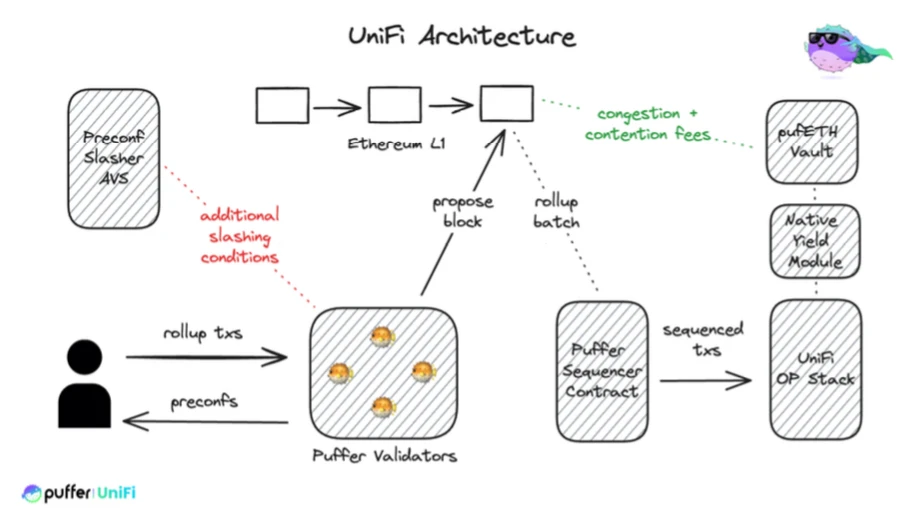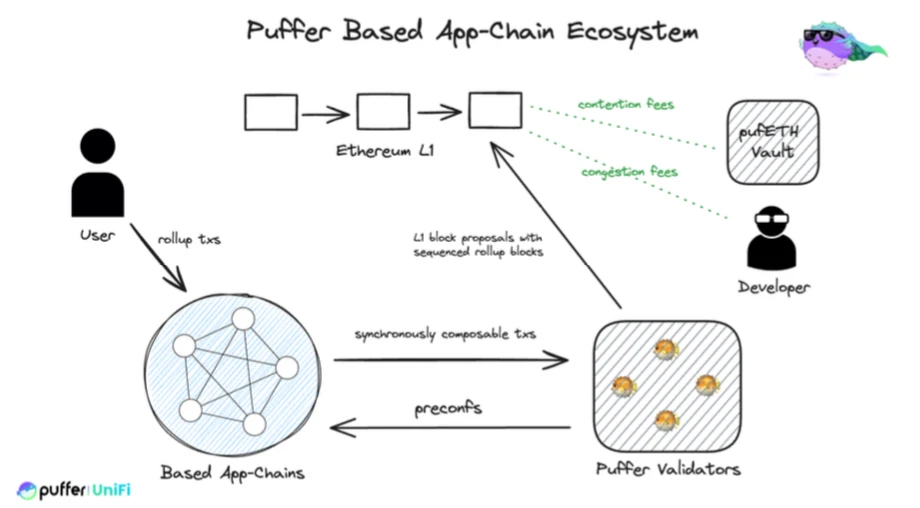Recently, Puffer Finance, a liquidity re-pledge protocol active on EigenLayer, launched a solution called Based Rollups, attempting to introduce ETH mainnet validators to provide a more secure and efficient decentralized solution for Rollups, especially the decentralization of the sorter.
As a classic LST protocol, it is a good narrative expansion to be able to provide new technical solutions based on its own characteristics (supporting both ETH mainnet PoS and Eigenlayer restaking).
The decentralization of the sorter is the core of the communitys attention. This is almost the weakest point of the Rollups system and can directly affect the user experience. Based Rollups attempts to outsource sorting to Layer 1 to achieve decentralized sorting, which not only reduces the risk of the current Rollups sorter being too centralized, but also significantly reduces transaction costs and improves system activity.
Developers can easily deploy and manage their own Rollups chains based on the Based Rollups architecture, just like deploying smart contracts, and enjoy the security and decentralization of Ethereum.
Current Problems with Rollups
Current ZK or OP Rollups rely on a centralized sorter to determine the order of transactions. This centralization brings risks, including sorter failure and reduced user trust, as well as the derived MEV problem.
To mitigate these risks, many Rollups provide an “escape hatch”, a mechanism that allows users to exit Rollups when the sorter fails, but this increases latency and gas fees and may result in malicious sorting and MEV extraction.
We desperately need Rollups with a decentralized sorter.
Introduction of Based Rollups
Rollups where the transaction order is determined by L1 are called Based Rollups, proposed by Justin Drake, a researcher at the Ethereum Foundation in March 2023.
Base Rollups achieves decentralized ordering by leveraging L1 proPoSer to determine the order of transactions. This approach not only inherits the liveness and decentralization of L1, but also eliminates the need for escape hatches, thereby enhancing the security and efficiency of Rollups.
How Based Rollups Work
In Base Rollups, L1 proPoSer can cooperate with L1 searchers and L1 builders to include Rollups blocks in the next L1 block without permission. That is, the order of the included L2 blocks and the final ordering of transactions are determined by L1 proPoSer. But in general, L1 proPoSer does not build L2 blocks by itself. Instead, each Based Rollups block is built by L2 builders. In other words, the work of L1 proPoSer will not be increased.
Taiko is a Based Rollups. The VM and Rollups execution agent of Based Rollups act as the execution layer to execute transactions off-chain. Starting from the consensus layer, the Ethereum consensus layer determines the transaction order, and the transaction data is also published on Ethereum. Finally, the transaction status can be verified on Ethereum.
Advantages of Based Rollups
Inheriting L1 anti-censorship and enhancing transaction activity: Since Based Rollups is operated by Ethereum L1 proPoSer and validator nodes, it inherits Ethereums anti-censorship and does not require an escape hatch. This ensures transaction activity and avoids transaction delays and unfairness caused by escape hatches.
Reduce transaction costs: Escape pod-based transactions usually incur additional gas costs, reducing the activity of traditional Rollups. However, transactions based on Rollups do not require additional gas fees, and do not need to verify the signature of the centralized sorter, and do not require escape pods or external PoS consensus, further reducing costs.
Inheriting L1 decentralization, the system is simpler and more secure: Based Rollups only executes the transaction layer off-chain, and the consensus layer, data visibility layer, and verification layer for sorting transactions are all on L1. This reuses the searchers-builders-proPoSer architecture of L1, making the Based Rollups system very simple, without the need for sequencer signature verification, escape hatches, or external PoS consensus. L1 searchers and block builders are incentivized to include Rollups blocks in their L1 bundles and L1 blocks to extract Rollups MEV, further enhancing the security of L1. By default, Based Rollups has almost no negative impact on L1 stakers, the only impact is an increase in income because most of the MEV flows to L1.
Flexible token governance: Although the ordering is delegated to L1, Based Rollups can still have governance tokens to collect basic fees. Of course, it can also be token-free because its correctness and fairness are guaranteed by Ethereum.
Challenges of Based Rollups
MEV revenue is forced to decrease
MEV is the bulk of traditional Rollups revenue, but most Based Rollups’ MEV flows to L1 proPoSer, which sacrifices Based Rollups’ MEV revenue and still retains the option to generate revenue from L2 congestion fees (such as EIP-1559-style L2 base fees).
However, Based Rollups that hope to capture their own MEV may have some bribery mechanisms. For example, the L1 contract may include an auction mechanism, such as a Dutch auction, forcing batch submitters to pay some ETH to the contract.
Limited sorting flexibility, no pre-confirmations
While Based Rollups are advantageous in many ways, they also face some challenges, particularly those related to soft confirmations, which are the ability for users to reliably know that their transactions will successfully reach Ethereum Layer 1 (L1).
Current Rollups provide pre-confirmations, allowing users to know that their transactions will definitely be submitted to L1.
However, Based Rollups entrusts sorting to L1, which reduces the flexibility of sorting, making it impossible to achieve pre-confirmations and Arbitrum-style first-come, first-served (FCFS) sorting.
And Justin Drake proposed using re-staking to solve the problem of Pre-confirmations in the summer of 2023. Using a re-staking design, a portion of L1 proPoSers submit (through re-staking) to include Based Rollups blocks in their future proposed L1 blocks. Since L1 proPoSers know at least 32 blocks in advance, it is possible to designate who is the proPoSer of which block.
Puffer Finance’s Improvements to Based Rollups
Puffer Finance aims to integrate pre-confirmation with Base Rollups through its UniFi architecture, providing fast (100ms) confirmation times while maintaining all the benefits of Base Rollups.
The pre-confirmation mechanism ensures that transactions are submitted to L1
Pre-confirmations ensure that decentralized sorters can effectively submit transactions to L1. Ethereum validators queue up to propose blocks. If pre-confirmers fail to fulfill their promises, they will face penalties such as margin cuts to ensure higher reliability. This mechanism gives users more confidence that their transactions will indeed be included in the Ethereum L1 state.
Fast 100 ms confirmation
For applications like GameFi, soft confirmations are critical to ensure fast response times (e.g., about 100 milliseconds). However, due to the decentralization of the sorter of Based Rollups, these validators follow the 12-second block generation time, resulting in a minimum confirmation time of 12 seconds, which makes soft confirmations unable to respond quickly.
Puffers UniFi integrates pre-confirmations (Preconfs) with Based Rollups, allowing Based Rollups to provide a user experience comparable to that of centralized sorters, providing 100 millisecond confirmation times and guaranteed activity. This integration allows Based Rollup to retain all of its original advantages, ultimately solving the problem of Ethereum liquidity fragmentation and promoting a more unified and efficient Rollup ecosystem.
UniFi Architecture
UniFis architecture enables it to quickly scale from a single centralized sorter to tens of thousands of decentralized sorters using Puffers validator nodes. UniFi hopes to seamlessly integrate pre-confirmation into its Based Rollup.
Users submit Rollup transactions, which are then processed by Puffer validators. These validators provide pre-confirmations, ensuring that users know their transactions will be included in the Ethereum L1 state.
Puffer validators re-stake with additional slashing conditions to ensure reliability, receive Rollup transactions from users and issue pre-confirmations. These validators prepare to include Rollup transactions in L1 blocks.
The pre-confirmation penalty mechanism (Preconf Slasher AVS) imposes additional slashing conditions on validators to disincentivize violations of pre-confirmation commitments and prevent validators from not submitting certain Rollup transactions to L1.
Puffer validators propose blocks to Ethereum L1 that include an order of pre-confirmed Rollups.
The Puffer sorter contract accepts Rollup transactions.
PufETH Vault collects congestion fees and contention fees generated by Rollup transactions, which increase the returns of PufETH holders and are returned to UniFi users through native returns.

uniETH can reduce market risks
unifETH is the universal gas token in the UniFi ecosystem. It generates rewards through pufETH and is managed by a decentralized autonomous organization (DAO) to avoid market risks such as loan liquidations caused by Ethereum price fluctuations, and Puffers anti-deduction mechanism can avoid these risks.
Gas-free transaction scenario
In Web2, users are used to free Internet services subsidized by advertising. In Web3, users need to pay for services, which may hinder user adoption.
Puffers Based Rollup users can earn income by locking assets in the Rollup native bridge, generating native yields, which enables Puffer to support some application scenarios such as transactions without Gas fees, which has important implications for both web2 and web3.
Puffers Based dApp Chain
If the transaction fees of a dApp on the Rollups chain become very high, developers may choose to leave the Rollups chain and create their own chain, so that they can directly obtain the benefits of user transaction fees. Puffer provides developers with the solution of Based dApp Chain.

For developers, launching a Puffer Based dApp chain becomes as easy as deploying a smart contract, and it inherits the security and decentralization characteristics of Ethereum. Developers can obtain transaction fees from the dApps Rollups chain, and no longer need to operate a centralized sorter themselves, and can realize cross-chain transactions and interactions.
Users transactions on Puffers Based dApp chain can be quickly confirmed within 100 milliseconds, and Puffers pre-confirmations can ensure that the transactions are submitted to L1.
Conclusion
Through cooperation with the Ethereum Foundation, Puffer Finance is providing a more secure and efficient solution for Rollups. This decentralized sorting method not only reduces the risks of the current centralized sorter, but also significantly reduces transaction costs and improves system activity.
With the integration of the pre-confirmation mechanism and 100 millisecond fast confirmation time, Base Rollups will become an ideal choice for various applications including GameFi, ensuring the finality of transactions while ensuring user experience. In addition, based on Puffer Finances Based dApp chain, developers can easily deploy and manage their own Rollups chains without worrying about the operation of centralized sorters, and enjoy the security and decentralization of Ethereum.










